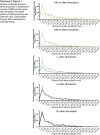Ultrafast endocytosis at Caenorhabditis elegans neuromuscular junctions
- PMID: 24015355
- PMCID: PMC3762212
- DOI: 10.7554/eLife.00723
Ultrafast endocytosis at Caenorhabditis elegans neuromuscular junctions
Abstract
Synaptic vesicles can be released at extremely high rates, which places an extraordinary demand on the recycling machinery. Previous ultrastructural studies of vesicle recycling were conducted in dissected preparations using an intense stimulation to maximize the probability of release. Here, a single light stimulus was applied to motor neurons in intact Caenorhabditis elegans nematodes expressing channelrhodopsin, and the animals rapidly frozen. We found that docked vesicles fuse along a broad active zone in response to a single stimulus, and are replenished with a time constant of about 2 s. Endocytosis occurs within 50 ms adjacent to the dense projection and after 1 s adjacent to adherens junctions. These studies suggest that synaptic vesicle endocytosis may occur on a millisecond time scale following a single physiological stimulus in the intact nervous system and is unlikely to conform to current models of endocytosis. DOI:http://dx.doi.org/10.7554/eLife.00723.001.
Keywords: C. elegans; active zone; high-pressure freezing; optogenetics; synaptic vesicle endocytosis; synaptic vesicle exocytosis; time-resolved electron microscopy.
Conflict of interest statement
The authors declare that no competing interests exist.
Figures














Comment in
-
The tortoise and the hare revisited.Elife. 2013 Sep 3;2:e01233. doi: 10.7554/eLife.01233. Elife. 2013. PMID: 24015361 Free PMC article.
-
Ultrafast synaptic endocytosis cycles to the center stage.Dev Cell. 2014 Jan 13;28(1):5-6. doi: 10.1016/j.devcel.2013.12.017. Dev Cell. 2014. PMID: 24434135
References
Publication types
MeSH terms
Grants and funding
LinkOut - more resources
Full Text Sources
Other Literature Sources

